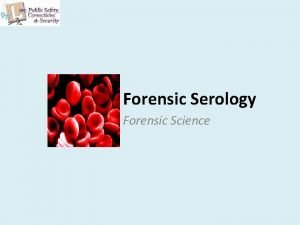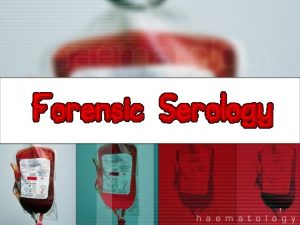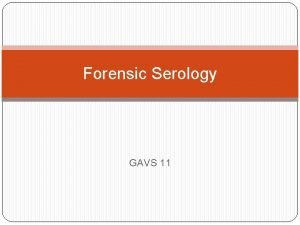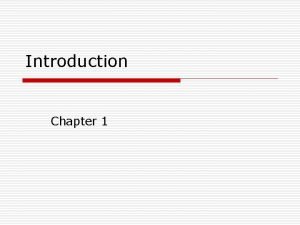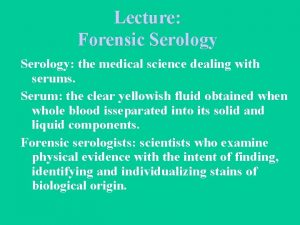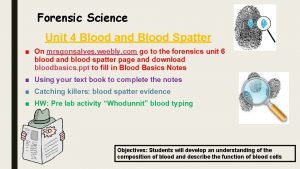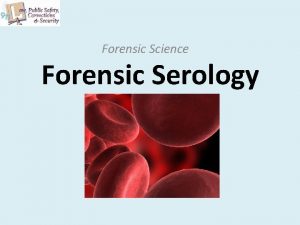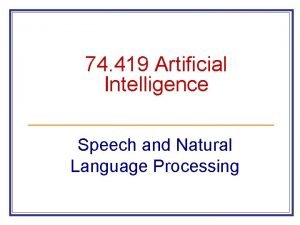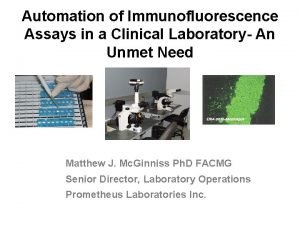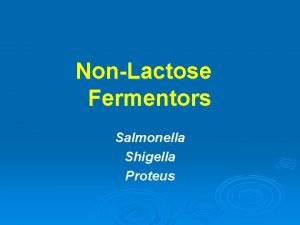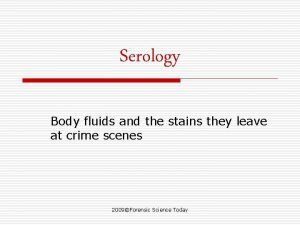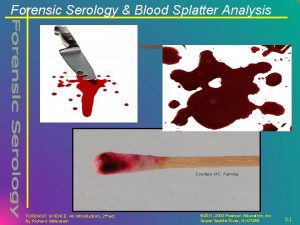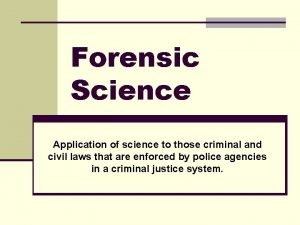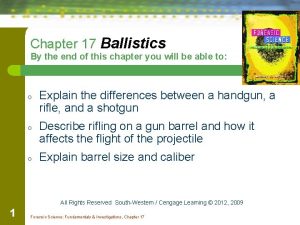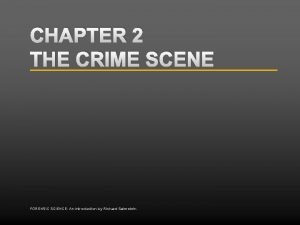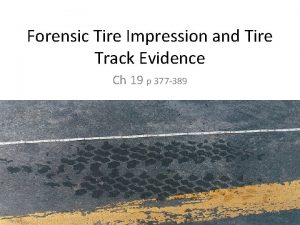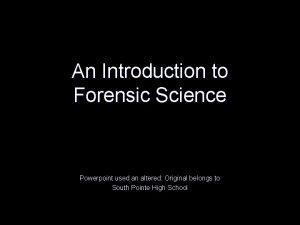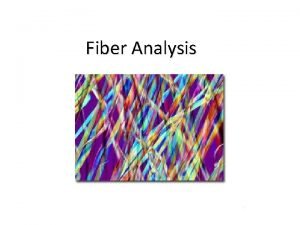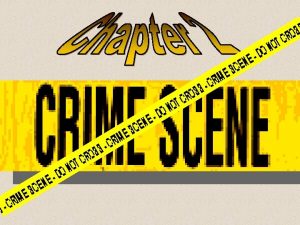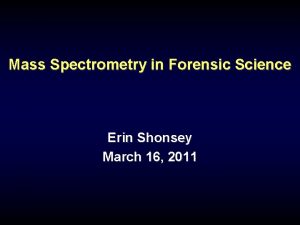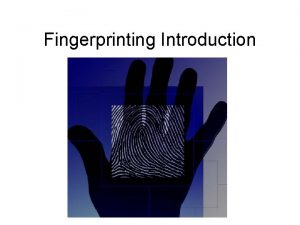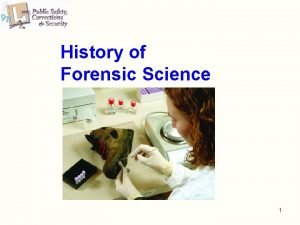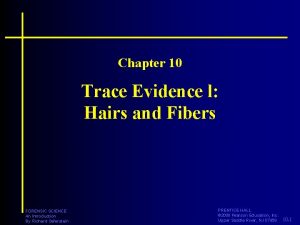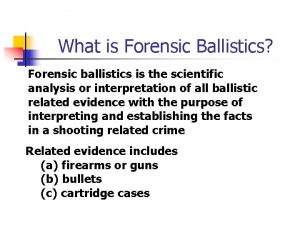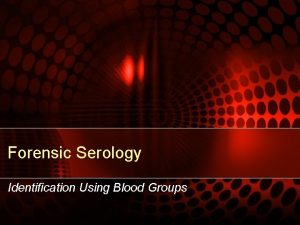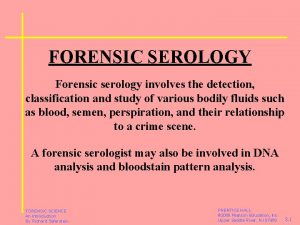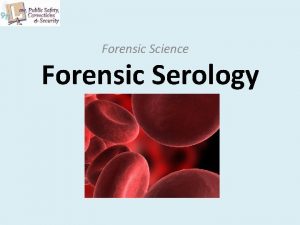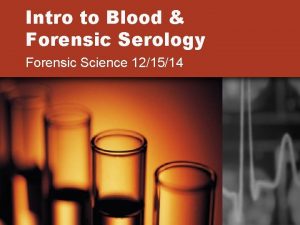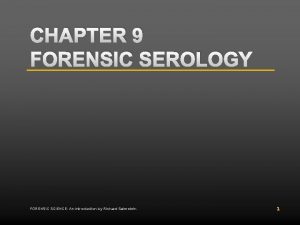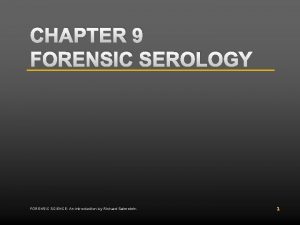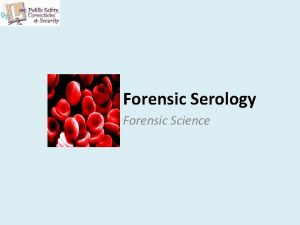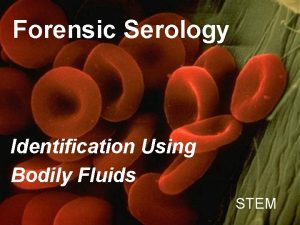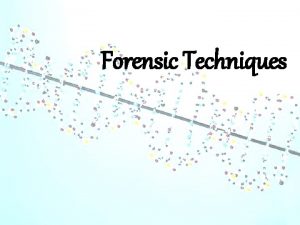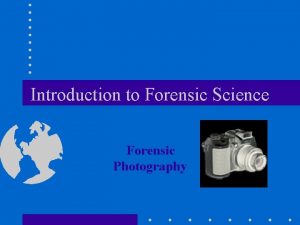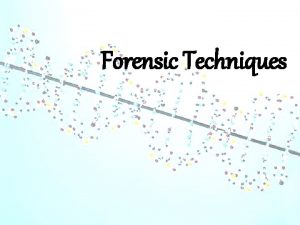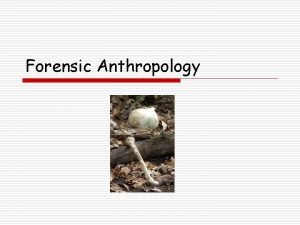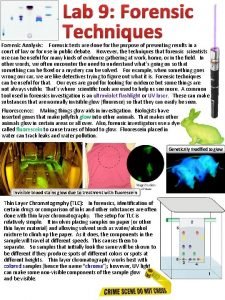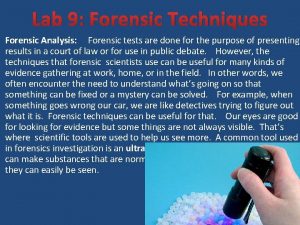FORENSIC SCIENCE Serology 1 What is Serology Serology






































- Slides: 38

FORENSIC SCIENCE Serology 1

What is Serology? Serology is the study of serums (body fluids) such as blood, saliva, semen and sweat. 2

Evidence that looks like blood When blood is found at a crime scene, several questions must be answered: Is it blood? If so, is it human or animal? If human, what type of blood is it? How did the blood fall or spatter? 3

1 st Question – Is it blood? A crime scene investigator cannot presume that every red stain or liquid is blood. Ketchup, spaghetti sauce and red jello may all be mistaken for blood. The investigator will perform presumptive tests at the scene to determine if the substance is blood. 4

The Presumptive Blood Tests Two of the common Presumptive Tests are color tests. Kastle-Meyer • phenolophthalein and hydrogen peroxide are mixed together • The mixture will react with the blood’s hemoglobin and cause the formation of a deep pink color. • Several household items will yield a false positive for a 5 color test. For example, potatoes and horseradish yield a false positive.

The Presumptive Blood Tests Hemastix the strip is moistened with distilled water and then dipped into the substance. A green color indicates blood. 6

The 3 rd Presumptive Blood Tests Luminol Is NOT a color test reacts with blood to produce light instead of color. Luminol detects blood even if the area has been cleaned. 7

It is blood, but is it human blood? At the lab, the technician will need to determine if the blood is human or animal. First, the technician will complete a microscopic examination. The red blood cells of mammals do not have a nucleus. This is an important distinction. 8

Human Blood Numerous red blood cells -- 5 to 6 million per mm 3 Red blood cells do not have a nucleus Larger but less numerous white blood cells 5 to 10, 000 per mm 3 Tiny, cellular fragments 350 to 50, 000 per mm 3 called platelets 9

Non-Mammalian Animal Blood Non-Mammalian red blood cells are more oval and the nucleus is present. Example: Frog Blood Larger nucleic red blood cells that undergo cell division No platelets 10

Test to determine if the blood is human blood? The next test that the technician will conduct is the precipitin test. This test is very sensitive and requires only a small amount of blood. An antiserum is mixed with a sample of blood. If it is human blood it will coagulate. The antiserum is made from the antibodies in the blood of rabbits. 11

It is human blood, but what type? In 1900, Karl Landsteiner discovered that there are four different kinds of human blood based on the presence or absence of specific antigens found on the surface of the red blood cells. In 1940 Landsteiner and Weiner reported the discovery of another blood antigen by studying the blood of the Rhesus monkey. Antigen D is thus commonly called the “Rh factor” 85% of Caucasians, 94% of Black Americans and 99% of all Asians are Rh positive. 12

Blood Reactions to Antiserum REACTION Anti-A Serum 13 Anti-B Serum BLOOD TYPE Agglutination No agglutination Type A No agglutination Agglutination Type B Agglutination Type AB No agglutination Type O

Blood Typing 14 Reactions to Anti-Serum

Population Distribution of Blood Types in the U. S. 15 Type Percent O 45 A 39 B 12 AB 4

The final question, how did the blood fall or spatter? A group of blood spatter specialists deal with the physical properties of blood and the patterns produced under different conditions as a result of various forces being applied to the blood. 16

The final question … how did the blood fall or spatter? Blood, as a fluid, follows the laws of physics. It is not influenced nor affected by race, gender, or age of the one bleeding. 17

BLOOD DROPLET Characteristics A blood droplet will remain spherical in space until it drops onto a surface Once a blood droplet impacts a surface, a bloodstain is formed. A droplet falling from the same height, hitting the same surface at the same angle, will produce a stain with the same basic shape. 18

BLOOD DROPLET Volume Is approximately 0. 05 cc Is not the same for all blood droplets--from 0. 03 cc to 0. 15 cc Is directly dependent upon the surface or orifice from which it originates The impact area is called the target. 19

Conditions Effecting Bloodstain Shape Height of the droplet Size of the droplet Angle of impact Velocity at which the blood droplet left the original surface Texture of the target surface Ø On clean glass or plastic--droplet will have smooth outside edges 20 Ø On a rough surface--will produce scalloping on the edges

Questions Answered by Blood Spatter Interpretation The distance between the target surface and the origin of blood at the time of blood shed The point(s) of origin of the blood Movement and direction of a person or an object The number of blows, shots, etc. causing the bloodshed and/or the dispersal of blood. 21

Questions Answered by Blood Spatter Interpretation continued… Type and direction of impact that produced the bloodshed The position of the victim and/or object during bloodshed Movement of the victim and/or object after bloodshed 22

Bloodstain Terminology Angle of impact - angle at which blood strikes a target surface. Bloodstain transfer - When a bloody object comes into contact with a surface and leaves a patterned blood image on the surface. Backspatter - blood that is directed back toward its source of energy. Cast-off - blood that is thrown from an object in motion 23

Bloodstain Terminology Contact stain - general term referring to bloodstains caused by contact between a wet, blood-bearing surface and a second surface which may or may not have blood on it Ø Transfer - image is recognizable and may be identifiable with a particular object Ø Swipe - wet blood is transferred to a surface which did not first have blood on it Ø Wipe - a non-blood bearing object moves 24 through a wet bloodstain, altering the appearance of the original stain

Wipe Swipe 25 Transfer

Bloodstain Terminology Terminal velocity--the greatest speed to which a free falling drop of blood can accelerate in air. It is dependent upon the acceleration of gravity and the friction of the air against the blood -approximately 25 feet/second. ØHigh velocity--greater than 100 feet/second; gives a fine mist appearance ØLow velocity--5 feet/second or less ØMedium velocity--5 to 25 feet/second. 26

27

28

29

Bloodstain Pattern Analysis Terms • Parent Drop – The droplet from which a satellite spatter originates. • Satellite Spatters – Small drops of Satellite Spatters Spines blood that break of from the parent spatter when the blood droplet hits a surface. • Spines – The pointed edges of a stain that radiate out from the spatter; can help determine the direction from which the blood traveled. Parent Drop

Blood Stain Patterns The shape of a blood stain: l l 31 Round--if it falls straight down at a 90 degree angle. Elliptical--Blood droplet elongates as the angle decreases from 90 to 0 degrees.

IMPACT The more acute the angle of impact, the more elongated the stain. 90 degree angles are perfectly round with 80 degree angles taking on a more elliptical shape. At about 30 degrees the stain will begin to produce a tail. The more acute the angle, the easier it is to determine the direction of travel. The greater the height the drop falls the larger the 32 spatter.

Angle of Impact and Spatter Shape 33

Height of the Droplet and Spatter Size 34

Blood Stains The harder and less porous the surface, the less the blood drop will break apart. The softer and more porous the surface, the more a blood drop will break apart. The pointed end of the blood stain faces the direction the stain is traveling. 35

Area of Convergence The line drawn through the long axis of each individual bloodstain can then be extended back to where the path of the blood drops intersect. This is called the area of convergence. 36

Area of Origin By calculating the angle of impact of each individual bloodstain and using the area of convergence, a 3 -dimensional area of origin can then be determined mathematically or physically using strings. 37

Void Pattern • Area within a blood spatter that is clean of any blood • Indicating some object was removed or a person was hit by spatter 38
 Cins ve tür arasındaki fark
Cins ve tür arasındaki fark Define forensic serology
Define forensic serology Forensic serology definition
Forensic serology definition Father of forensic serology
Father of forensic serology Father of forensic serology
Father of forensic serology Hemastix definition
Hemastix definition Sir arthur conan doyle contribution forensic science
Sir arthur conan doyle contribution forensic science Father of forensic toxicology
Father of forensic toxicology Who is this
Who is this Thomas mocker and thomas stewart
Thomas mocker and thomas stewart What's your favourite subject at school
What's your favourite subject at school Forensic science blood basics notes
Forensic science blood basics notes Lines of convergence definition forensics
Lines of convergence definition forensics Serology book
Serology book Prometheus celiac serology
Prometheus celiac serology Proteus non lactose fermenter
Proteus non lactose fermenter Spermatazoa
Spermatazoa Serology
Serology Blood spatter direction of travel
Blood spatter direction of travel Leone lattes contribution to forensic science
Leone lattes contribution to forensic science What is nibis
What is nibis Line/strip search pattern
Line/strip search pattern Tire track width
Tire track width Chapter 1 intro to forensic science
Chapter 1 intro to forensic science Forensic criminalist
Forensic criminalist Branches of forensic science ppt
Branches of forensic science ppt Fiber definition forensics
Fiber definition forensics Calvin goddard contribution to forensic science year
Calvin goddard contribution to forensic science year Forensic science begins
Forensic science begins Mass spectrometry in forensic science
Mass spectrometry in forensic science Testimonial evidence
Testimonial evidence Deductive reasoning definition forensic science
Deductive reasoning definition forensic science What are the 3 fundamental principle of fingerprints?
What are the 3 fundamental principle of fingerprints? Deductive reasoning definition forensic science
Deductive reasoning definition forensic science Locard's exchange principle
Locard's exchange principle Hairs and fibers in forensic science
Hairs and fibers in forensic science Forensic anthropology unit
Forensic anthropology unit Intermediate between round-nose and wadcutter.
Intermediate between round-nose and wadcutter. Forensic science unit 1 review
Forensic science unit 1 review
